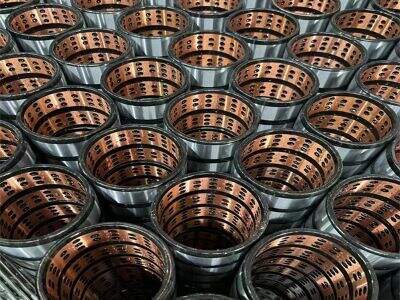Wyobraź sobie na przykład pociąg toczący się po torach. Obserwuj, jak koła się kręcą, ale tory pozostają nieruchome pod nimi. To naprawdę zadziwiający widok! Ale jeśli tory nie są wystarczająco mocne i stabilne, pociąg może również runąć. Jest to bardzo poważny problem.” Wtedy zaczynają działać wałki nośne. Dowiedzmy się więcej o tym, jak wałki nośne utrzymują tory w zaciśnięciu i dlaczego jest to takie ważne.
Co to są wałki nośne?
Waleczki nosne są specjalnymi, okrągłymi elementami, które nieprzerwanie toczą się między torami a maszyną poruszającą się po nich. Znajdują się w różnych miejscach systemu torowego, takich jak podwozie, łańcuch torowy i ramy torów. Waleczki nosne bezpośrednio nie dźwigają ciężaru maszyny, ich głównym zadaniem jest dystrybucja wagi maszyny na torze. To ogromna różnica, ponieważ zapobiega to powstaniu słabszych punktów na torach. Jeśli te słabe punkty się pojawią, mogą one prowadzić do poważnych problemów lub wypadków. Podejrzewam, że waleczki nosne są częściowo odpowiedzialne za bezpieczeństwo wszystkiego!
Więc, jak utrzymujemy równowagę torów? Wtedy wchodzą w grę waleczki nosne.
Wyważenie jest jednym z najważniejszych czynników w utrzymaniu stabilności i efektywności systemu torowego. Maszyna nie jest doskonała, jeśli jej wyważenie jest zaburzone, ponieważ może się przewrócić lub co najmniej zakołysać, co wcale nie jest dobre. Kolejki nośne rozprowadzają ciężar po torze, aby utrzymać równowagę w systemie torowym. Wraz z innymi elementami torowymi, takimi jak łącza torowe, kółka ześlizgowe i naciągniki, pomagają zapewnić, że maszyna porusza się płynnie i jest wyważona. Podobnie jak potrzebujesz równowagi podczas jazdy na rowerze, to samo dotyczy maszyn!
Projektowanie dźwigów sufitowych i kolejek nośnych w ciężkich maszynach
Teraz przechodzimy do dużych maszyn, takich jak buldożery i wykopowe. Te maszyny są przeznaczone do przemieszczania dużej ilości ziemi i innych ciężkich obiektów. Aby wykonywać swoje zadania poprawnie i bezpiecznie, wymagają solidnych systemów gąsienicowych. Walec nośny odgrywa kluczową rolę w tych ciężkich maszynach. Pomagają one utrzymać równowagę maszyn i zapewnić, że nie wywierają zbyt duży nacisk na słabo rozwinięte obszary gąsienicy. Brak wałków nośnych manifestowałby się zniszczeniem gąsienicy przez duże maszyny, co prowadziłoby do wypadków oraz utraty zdolności operacyjnej.
Jak działają wałki nośne
Aby zobaczyć, jak wałki przewodnicze przyczyniają się do poprawy stabilności toru, musimy zbadać ich działanie. To znaczy, że wałki przewodnicze kręcą się i toczą po torze. Są one połączone z maszyną za pomocą osi, która jest wyrownana równolegle do toru. Ciężar jest równomiernie rozprowadzany na wałkach przewodnictwa w momencie, gdy maszyna rusza do przodu. To pomaga utrzymać harmonię w naszym domu. Teraz, gdyby nie było wałków przewodnictwa, waga maszyny skupiłaby się na某些 punktach toru, co prowadziłoby do nierównego zużycia tej części. Później mogłoby to spowodować więcej problemów, a chcemy tego uniknąć za wszelką cenę!
Jak poprawnie zainstalować wałki przewodnicze
Poprawne przedstawienie wałków przewodnich jest kluczowe dla najlepszego działania układu torowego. Muszą być poprawnie zainstalowane i regularnie testowane, aby upewnić się, że są operational. Naprężenie toru jest krytyczne do odpowiedniego zainstalowania wałków przewodnich. To samo naprężenie pomaga maszynie utrzymać poziom, co minimalizuje ryzyko uszkodzeń lub wypadków. Dosłownie to jak nastrajanie gitary; im więcej danych wprowadzasz, tym mocniej musisz naciągać struny!
Wreszcie, nośnik rolkowy jest ważnym czynnikiem, który przyczynia się do zapewnienia bezpieczeństwa systemu torowego oraz bezpieczeństwa w ogóle. Rozprowadzają one ciężar maszyny równomiernie, co gwarantuje równowagę i uniemożliwia uszkodzenia. Rolki nośnikowe mogą pomóc maszynom w płynnej i bezpiecznej pracy, o ile są prawidłowo zainstalowane i poddawane profilaktyce. W Loonsin rozumiemy wagę rolek nośników i jesteśmy zaangażowani w dostarczanie wysokiej jakości części, które pozwalają na poprawne działanie waszych maszyn. Gdy zmniejszysz wszystkie czynniki pracujące razem, prowadzi to do bezpieczniejszej i bardziej efektywnej pracy!

 EN
EN
 AR
AR
 BG
BG
 HR
HR
 CS
CS
 DA
DA
 NL
NL
 FI
FI
 FR
FR
 DE
DE
 EL
EL
 HI
HI
 IT
IT
 JA
JA
 KO
KO
 PL
PL
 PT
PT
 RO
RO
 ES
ES
 SV
SV
 TL
TL
 ID
ID
 SR
SR
 SK
SK
 SL
SL
 UK
UK
 VI
VI
 HU
HU
 TH
TH
 TR
TR
 FA
FA
 MS
MS
 BN
BN
 KM
KM
 LO
LO
 LA
LA
 NE
NE
 MY
MY
 SU
SU
 UZ
UZ

